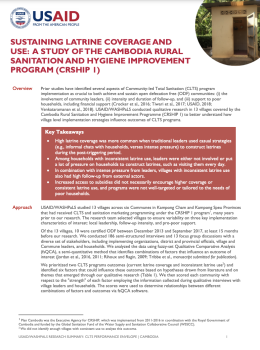Sustaining Latrine Coverage and Use: A Study of the Cambodia Rural Sanitation and Hygiene Improvement Program (CRSHIP I)
Summary
Prior studies have identified several aspects of Community-led Total Sanitation (CLTS) program implementation as crucial to both achieve and sustain open defecation free (ODF) communities: (i) the involvement of community leaders, (ii) intensity and duration of follow-up, and (iii) support to poor households, including financial support (Crocker et al., 2016; Tiwari et al., 2017; USAID, 2018; Venkataramanan et al., 2018). USAID/WASHPaLS conducted qualitative research in 13 villages covered by the Cambodia Rural Sanitation and Hygiene Improvement Programme (CRSHIP 1) to better understand how village level implementation strategies influence outcomes of CLTS programs.
Key Takeaways:
- High latrine coverage was more common when traditional leaders used casual strategies (e.g., informal chats with households, verses intense pressure) to construct latrines during the post-triggering period.
- Among households with inconsistent latrine use, leaders were either not involved or put a lot of pressure on households to construct latrines, such as visiting them every day.
- In combination with intense pressure from leaders, villages with inconsistent latrine use also had high follow-up from external actors.
- Increased access to subsidies did not necessarily encourage higher coverage or consistent latrine use, and programs were not well-targeted or tailored to the needs of poor households.


